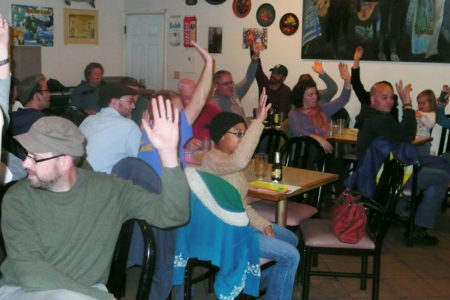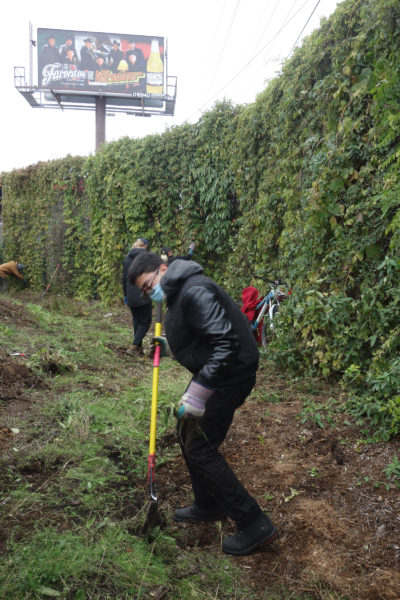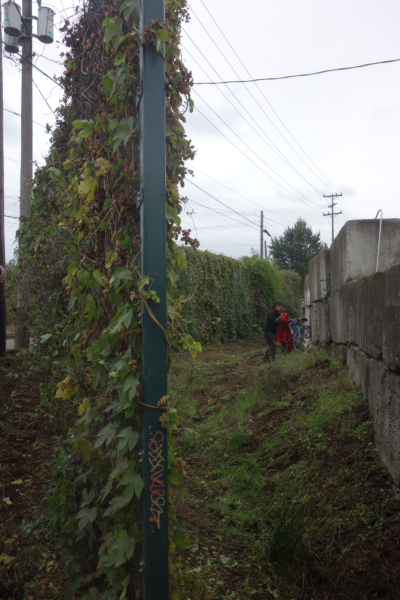“I felt like I had to take a running start to breathe,” says homeowner Kelly Welker of Georgetown, a mostly industrial area on the Duwamish River in South Seattle, in the Seattle Weekly. She was speaking of her 2015 experience at the time. Residents’ eyes were burning. A chalky, caustic dust billowed through the air, settling on their homes, stinging their noses and throats, and causing piercing headaches, nosebleeds, and in some cases asthma attacks.
Almost all of the Duwamish River Valley in South Seattle is zoned industrial; five miles of the Lower Duwamish River itself is now (2021) a multimillion-dollar Superfund site whose resident fish are too toxic to consume. The slim rectangle of family homes in the Georgetown neighborhood are flanked by industrial facilities and freight-train tracks; diesel trucks regularly cough out all sorts of fumes and particulates.
Community Goals

A community group gathers to discuss needs in the Duwamish Valley. Photo courtesy of greenscreen
Air, water, soil, and food contamination were not new to the Georgetown community. Studies led by JHA and Duwamish River Cleanup Coalition (DRCC) showed that the Duwamish Valley is disproportionately impacted by environmental contamination and has less resources than the rest of Seattle. The CHIA (Cumulative Health Impact Analysis) showed Duwamish Valley residents have a 13-year shorter life expectancy relative to that of residents in wealthier and adjacent neighborhoods, and childhood asthma hospitalization rates were, at the time, the highest in the city.
Client Response and Resolution
In 2015, after residents’ complaints and the city’s response, one particular toxic-dust culprit—a construction-debris-recycling facility called CDL Recycle—temporarily closed its Georgetown location. The community recognized their environmental justice concerns, and that their issues would only be addressed by successfully navigating the EPA’s requirements to identify sources of environmental pollution and its effects.
By a majority vote and after months of research and data collection, the community, led by JHA and the DRCC, the project’s titular developer and client, chose to install a freestanding greenscreen system to perform environmental services and be aesthetically pleasing.
Environmental Goals for a Green Facade Solution
The Duwamish Valley greenscreen green facade is, in the words of the community, “a green wall without a building,” and was voted the top “most effective option for mitigating air pollution.”
The environmental services and performance values chosen by the Georgetown community (the client) are for a solution that:
- Mitigates air pollution
- Can be installed anywhere
- Creates a “wall of green”
- Can be installed where trees cannot
- Doesn’t require a building for support
- Can be aesthetically pleasing
- Will be successful with minimal maintenance
- Thrives using locally viable vines
- Offers opportunities for learning basic construction and maintenance skills
- Is an example of support for a variety of plants and habitat for birds and insects.
- Duwamish Community Green Wall, Maintenance Operations, October 2020. Photo by Linn Gould
- Georgetown Community green wall effectively screening Recycling Facility. They used Clematis, Honeysuckle, Hydrangea, and Virginia Creeper vines. Irrigation was done by a timer-activated drip system and in dry season only. Photo by Linn Gould
The installation was completed in fall 2016 by 13 project partners/groups of volunteers. Recent photos of the project show a mature and thriving green facade that fulfills most of the client’s expectations. For example:
- Mitigates air pollution from common urban sources.
Spectrographic and simulation testing of mature vegetated infrastructure in urban environments of various designs, where dust, airborne particles from automobiles and industry circulate, show how leaf surfaces trap pollution. The polluting particles are sequestered when leaves fall and become mulch. - Cools the local environment.
Elementary physics explains and validates the capacity of mature vegetation to cool proximal air temperatures by as much as 25 degrees Fahrenheit by evapotranspiration on the hottest days. - Is simple to install using common building skills.
The greenscreen system can be installed in most locations and soil conditions. The supporting structure must be engineered and footings designed according to expected wind loads and soil conditions.
Lessons Learned
Build a smaller green wall for the experience first.
Make sure to work closely with the engineer to discuss design changes and find creative solutions.
Don’t order materials until design and permit are approved.
Make sure the footing design is appropriate for a tall structure.
“Appreciation by the community and the environmental benefits makes the project worth doing despite any and all challenges,” says Linn Gould, director of Just Health Action.




